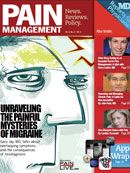Publication
Article
Pain Management
Poisonings Associated with Opioid Medications Are on the Rise among Children and Adolescents
The increase in the number of young children seen in the emergency department and/or admitted to the hospital due to inadvertent ingestion of prescription and OTC analgesics can be only partially explained by the increase in prescriptions and sales of these medications.
The authors of the article “Growing Impact of Pediatric Pharmaceutical Poisoning” (http://hcp.lv/q70oLP), published in the Journal of Pediatrics, looked at National Poison Data System of the American Association of Poison Control Centers patient records from 2001-2008 for children age 5 and younger who were “evaluated in a health care facility following exposure to a potentially toxic dose of a pharmaceutical agent” (including OTC and prescription medications). The authors reported that opioid analgesics were associated with “both a high number of associated total [emergency department] visits and a significant growth in admission rate and/or injury rate.” Specifically, the data revealed a 101% increase in ED visits from 2001-2008 due among children age 5 and younger due to unintentional ingestion of a prescription opioid analgesic, with an 86% increase in the rate of hospital admissions following evaluation in the ED. For OTC pain relievers, the data showed a 57% increase in ED visits over that time due to unintentional ingestion of acetaminophen, and a 29% increase for non-acetaminophen OTC analgesics. For unintentional therapeutic error involving prescription opioids, the data showed a 50% increase in ED visits, with a 68% increase in the rate of admissions. Unintentional therapeutic error associated with OTC acetaminophen products resulted in a 71% increase in ED visits; there was a 169% increase in ED visits due to unintentional therapeutic error involving non-acetaminophen OTC analgesics.
For prescription opioids, this increase may have been a corollary of the increase in the number of prescriptions written for these products over the same time period. The authors of the study reported that trend analysis of DEA data for 2000-2007 showed that “prescriptions for oxycodone increased 182%; hydrocodone, 159%; morphine, 159%; methadone, 559%; and fentanyl, 222%”
In their discussion of their findings, the authors wrote that the number of children who visit the ED after ingesting medications is increasing, with the chief cause being “children finding and ingesting medication by themselves.” Prescription pharmaceuticals, “particularly opioid analgesics,” sedatives, and cardiovascular medications, were associated with the largest increases in admissions and injury. According to the authors, this increase in ED visits is most likely due to the “rise in the number of medications in the environment of small children.” The dramatic increases in the number of prescriptions for opioid medications over this time period bear this out. Similarly, on the OTC side, the authors posited that “the rise in the number of visits following self-ingestion of OTC medications (59% for acetaminophen) without a change in the admission or injury rate can be explained only by more medication being available in the home or by less effective home prevention,” with the greater availability of OTC analgesics (they cited FDA data showing a showed a 28% increase in OTC acetaminophen use from 2004-2008) possibly due in part to “the increased societal emphasis on pain management.”
Resources on the Safe Handling, Storage, and Disposal of Pain Medications
What is the best way to safely store and dispose of opioids? Kathryn L Hahn, PharmD, CPE, DAAPM, of the American Pain Foundation, offers valuable advice and guidance on the safe storage of prescription opioids.
Disposal of Unused Medicines: What Consumers Should Know This resource from the FDA includes a list of medications recommended for disposal by flushing down the sink or toilet, along with information about safely disposing of other forms of medication.
Interestingly, the authors also posited that “the increase in the admission rate and severity for certain medications may be related to an increasing use of sustained-release medications and substitution of more potentially toxic medications.” As an example, they noted that as the use of hydrocodone and oxycodone has risen, the use of codeine has fallen.
Inadequate efforts at safe storage and other “poison proofing” measures may have contributed greatly to these results; the authors suggested that safety efforts may have “plateaued or declined.” They wrote that medication users may “find it inconvenient to store medication in locked cabinets,” may not “understand the life-threatening impact of some medications,” may “discount the potential toxicity of OTC medications,” or “underestimate the likelihood that [accidental ingestion or other misuse or diversion] will happen in their home with their children.”
This study, when combined with other recent reports and commentary documenting the increased risk of misuse, abuse, and diversion of prescription and OTC pain medications by children and adolescents underscores the need for enhanced “clinical teaching and training practices for physicians, nurses, dentists, and pharmacists in the areas of pain management, opioid pharmacology, and abuse/addiction,” combined with clinician-driven initiatives to educate patients, parents, and the public and make them “more aware and responsible for the use, storage, and disposal of opioid analgesics” (http://hcp.lv/oqX6Nh).
